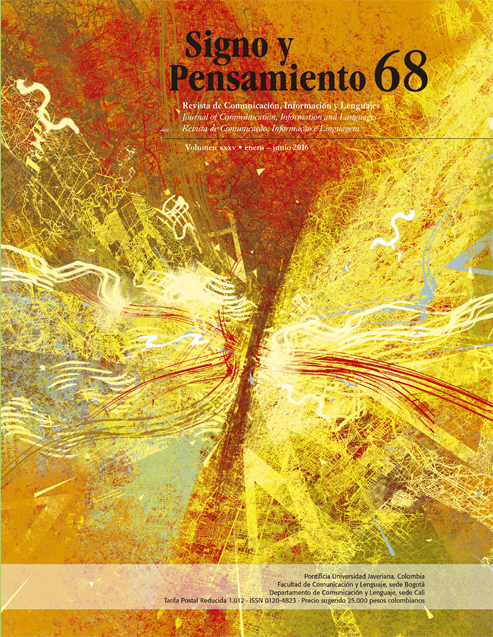Abstract
Upon the development of a research about the representations of art, it is intended to speci-fy the analytical challenges proposed by syncretic and multimodal signifying practices, such as films. In order to solve the problem of immanent analysis of such mediations and semiotic objects, it is used the model that Jacques Fontanille proposed to address the levels of relevance on the cultural practices. Such model is presented through the analysis of the Colombian film Los retratos (The Portraits). This work demonstrates the relevance of the analytical method for treating the different layers that affect cultural object, understood as signifying practice, and characterized by the constitutive complexity.
Basso Fossali, P. y Dondero, M. G. (2011). Sémiotique de la photographie. Limoges: Pulim.
Bertand, D. (2006). Croire au bleu: Chromatisme et fiducie. En La verité des images. Actes du colloque CeReS-Dynalang. Recuperado de http://epublications.unilim.fr/revues/ as/3380.
Eco, U. (1999). Kant et l’ornithorynque. París: Grasset.
Eco, U. (1992). Los límites de la interpretación. Barcelona: Lumen.
Édeline, F. y Klinkenberg, J. M. (2015). Principia semiotica. Aux sources du sens. Bruselas: Les Impressions Nouvelles.
Fontanille, J. (2015). Formes de vie: des jeux de langage à la phénoménologie des cultures. Metodo: International Studies in Phenomenology and Philosophy, 3(1).
Fontanille, J. (2013). Medios, regímenes de creencia y formas de vida. Revista Contratexto, 21, 65-82.
Fontanille, J. (2008). Pratiques sémiotiques. París: Puf. Fontanille, J. (2003). Sémiotique du discours. Limoges: Pulim.
Fontanille, J. (1999). Modes du sensible et syntaxe figurative. Limoges: Pulim. Fontanille, J. (1995). Sémiotique du visible. Des mondes de lumière. París: Puf.
Greimas, A. J. (1976). Sémiotique et sciences sociales. París: Seuil. Greimas, A. J. y Courtés, J. (1993). Sémiotique. Dictionnaire raisonné de la théorie du langage. Paris: Hachette.
Huys, V. y Vernant, D. (2012). L’interdisciplinaire de l’art. París: Presses Universitaires de France.
Lipovestsky, G. y Serroy, J. (2010). La culturamundo. Respuesta a una sociedad desorientada. Barcelona: Anagrama.
Lipovestsky, G. y Serroy, J. (2009). La pantalla global. Cultura mediática y cine en la era hipermoderna. Barcelona: Anagrama.
Lotman, Y. (1996). La semiosfera I. Semiótica de la cultura y del texto. Madrid: Cátedra, Frónesis y Universidad de Valencia.
Niño, D. (2015). Elementos de semiótica agentiva. Bogotá: Editorial Universidad Jorge Tadeo Lozano.
Paveau, A. (2006). Les prédiscours. Sens, mémoire, cognition. París: Presses Sorbonne Nouvelle.
Pérez, D. (Productora) y Gaona, I. (Director). (2012). Los retratos [Cortometraje]. Bogotá: La Banda del Carro Rojo Producciones, HD Cinema Colombia, Lapost TV y Fondo para el Desarrollo Cinematográfico de Colombia.
Rosales, J. H. (2006). Représentations de la culture de soi et de la culture de l’autre dans le discours universitaire en Colombie. Limoges: CeReS. Recuperado de http://epublications.unilim. fr /revues/as/4452
Rosales, J. H. y Uribe, L. (2015). Las diosas de la artista plástica Elsa Sanguino como medio de comprensión y cuidado de sí mismo como sujeto autónomo. En Actas del VII Congreso Internacional de Análisis Textual. Madrid: Universidad Complutense, Recuperado de http://www.tramayfondo.com/actividades/ vii-congreso/las_diosas/titulos-conferenciascom.html
This journal is registered under a Creative Commons Attribution 4.0 International Public License. Thus, this work may be reproduced, distributed, and publicly shared in digital format, as long as the names of the authors and Pontificia Universidad Javeriana are acknowledged. Others are allowed to quote, adapt, transform, auto-archive, republish, and create based on this material, for any purpose (even commercial ones), provided the authorship is duly acknowledged, a link to the original work is provided, and it is specified if changes have been made. Pontificia Universidad Javeriana does not hold the rights of published works and the authors are solely responsible for the contents of their works; they keep the moral, intellectual, privacy, and publicity rights.
Approving the intervention of the work (review, copy-editing, translation, layout) and the following outreach, are granted through an use license and not through an assignment of rights. This means the journal and Pontificia Universidad Javeriana cannot be held responsible for any ethical malpractice by the authors. As a consequence of the protection granted by the use license, the journal is not required to publish recantations or modify information already published, unless the errata stems from the editorial management process. Publishing contents in this journal does not generate royalties for contributors.


